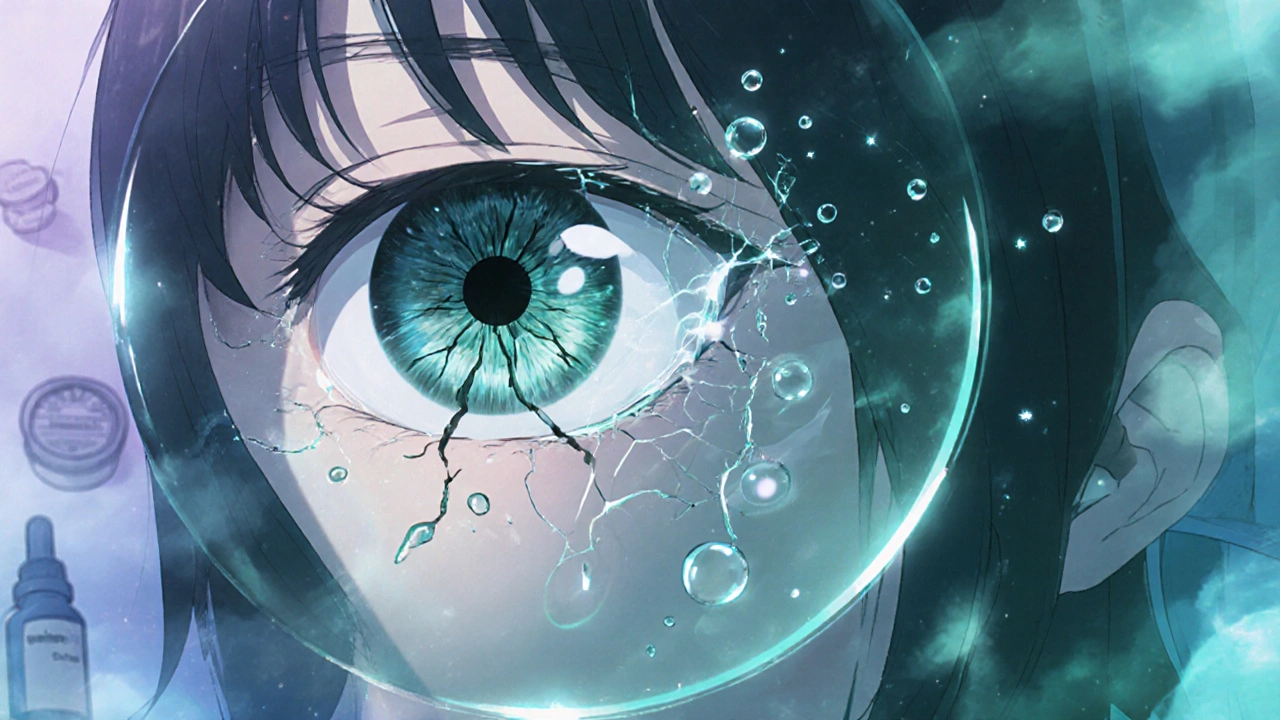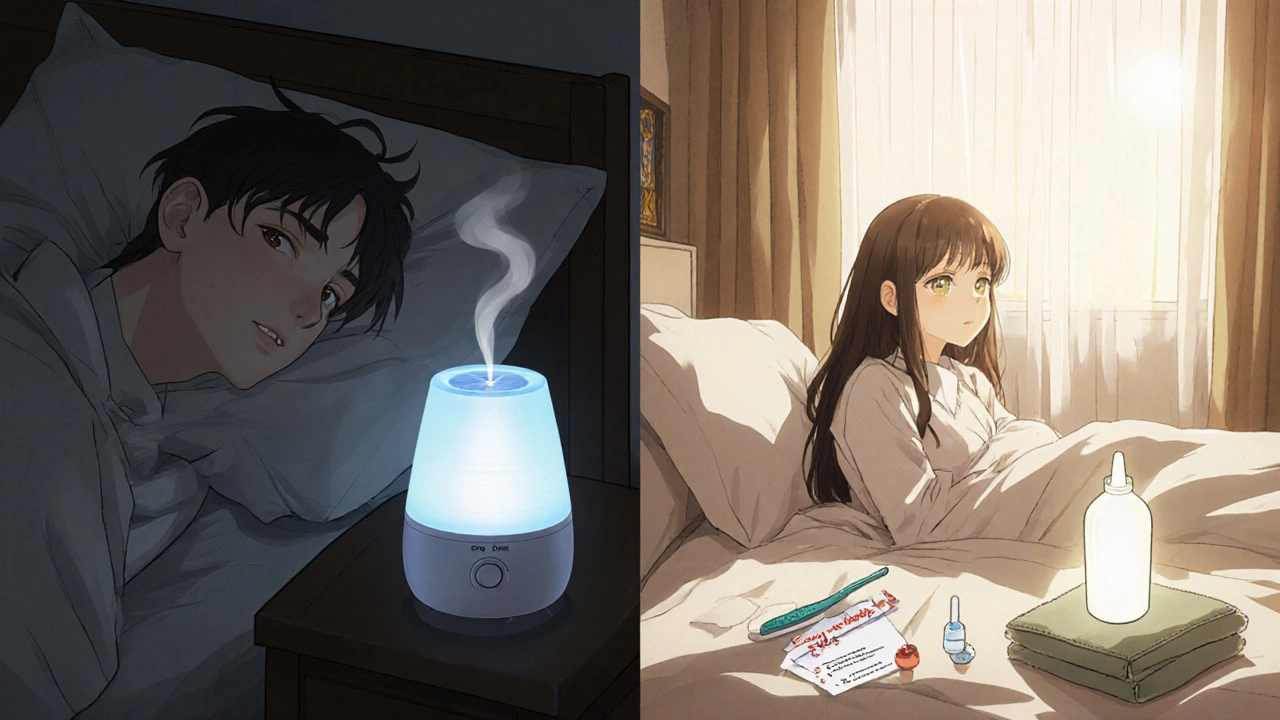What Causes Dry Eyes When You’re on Medication?
Many people don’t realize that common medications can make dry eyes worse-or even cause them. Antihistamines for allergies, antidepressants, blood pressure pills, birth control, and even acne treatments like isotretinoin can reduce tear production. If you’ve started a new medication and suddenly feel grit, burning, or blurry vision, it’s not just coincidence. Dry eye disease isn’t just about being in a windy room or staring at screens too long. It’s often a side effect you didn’t sign up for.
According to the Tear Film & Ocular Surface Society’s 2017 report, about 16.4 million adults in the U.S. have dry eye disease, and nearly 86% of those cases are evaporative dry eye-meaning your tears evaporate too fast because the oily layer on top of them is thin or broken. That’s where lubricants and humidifiers come in. They don’t fix the root cause, but they give your eyes breathing room while you work on the bigger picture.
Over-the-Counter Lubricants: What Actually Works?
Not all artificial tears are the same. You can’t just grab the cheapest bottle off the shelf and expect relief. The key is matching the viscosity to your symptoms.
Low-viscosity drops like Refresh Tears or Systane Ultra are thin, clear liquids. They’re great for mild dryness and can be used 2-4 times a day without blurring your vision. But they only last 1-2 hours. If you’re constantly reaching for them, you’re probably dealing with moderate to severe dry eye.
High-viscosity gels like Refresh Celluvisc or GenTeal Gel are thicker. They stick around longer-up to 4-6 hours-and are better for nighttime use or if your eyes feel gritty all day. The trade-off? They blur your vision briefly after application. Use them before bed or when you don’t need to drive or read right away.
Look for ingredients like sodium hyaluronate (0.1-0.4%), carboxymethylcellulose (0.5-1%), or polyethylene glycol. These mimic natural tear components. Avoid drops with preservatives like benzalkonium chloride if you’re using them more than 4 times a day. Preservative-free single-dose vials are gentler on sensitive eyes.
Prescription Lubricants: Faster, Stronger, But Costlier
If OTC drops aren’t cutting it, your eye doctor might prescribe something stronger. These aren’t just fancy tears-they target inflammation, the hidden driver behind chronic dry eye.
Restasis (cyclosporine 0.05%) has been around since 1998. It works by calming down the immune system’s attack on your tear glands. But here’s the catch: it takes 3 to 6 months to show results. If you’re expecting quick relief, you’ll be disappointed. A 2023 review found only 52% of users stick with it past 6 months because of the initial burning sensation. Refrigerating the drops helps reduce that sting.
Xiidra (lifitegrast 5%) works faster-some people feel better in 2 weeks. It blocks a specific inflammatory signal between immune cells. But 25% of users report stinging or discomfort when they apply it. It’s pricier too: $450-$550 for a 30-day supply without insurance.
Miebo (perfluorohexyloctane 3.5%) is the newest player, approved in 2023. It doesn’t increase tear production. Instead, it forms a protective shield over your eye, stopping tears from evaporating. That’s why it gives immediate relief. Clinical trials showed 1.5 times more improvement in dryness symptoms than placebo within 15 days. The downside? It costs about $650 for a month’s supply. And you can’t wear contacts for 30 minutes after using it.
There’s also Eysuvis (loteprednol), a short-term steroid drop for flare-ups, and Tyrvaya, a nasal spray that stimulates tear production through nerve reflexes. It’s $200 a month and surprisingly effective for some, but not everyone responds.
Comparing Prescription Dry Eye Drops
| Medication | Active Ingredient | Onset of Action | Duration of Effect | Typical Cost (30-day supply) | Common Side Effects |
|---|---|---|---|---|---|
| Restasis | Cyclosporine 0.05% | 3-6 months | Long-term (daily use) | $150-$250 (generic) | Burning, stinging |
| Xiidra | Lifitegrast 5% | 2 weeks | 12 hours per dose | $450-$550 | Stinging, eye irritation |
| Miebo | Perfluorohexyloctane 3.5% | Immediate | 4-6 hours | $650 | Minimal (0.16% discontinuation rate) |
| Eysuvis | Loteprednol 0.25% | Days | Short-term (10-day course) | $400 | Blurred vision, headache |
| Tyrvaya | Varenicline 0.03 mg/mL | 1-2 weeks | 6-8 hours per spray | $200 | Sneezing, throat irritation |

Humidifiers: The Silent Hero in Dry Eye Relief
You don’t need a fancy device. Just a humidifier running in your bedroom at night can make a huge difference. Dry indoor air-especially from heating systems in winter or air conditioning in summer-pulls moisture out of your eyes. That’s why so many people wake up with red, gritty eyes.
A 2024 survey of 342 dry eye patients found that 72% saw better nighttime symptoms when they used a humidifier set between 40% and 60% humidity. That’s the sweet spot: high enough to keep your tear film stable, low enough to avoid mold or dust mites.
Ultrasonic humidifiers are quiet and efficient. Cool mist models are safer around kids and pets. Clean them weekly with vinegar and water to prevent bacteria buildup. Don’t just run it all day-use it while you sleep. That’s when your eyes are closed, resting, and most vulnerable to evaporation.
Pair it with a warm compress before bed. The heat helps melt blocked oils in your eyelid glands, which improves the lipid layer your tears need to stay put. It’s a simple combo: humidifier + warm compress = fewer morning flare-ups.
Why Adherence Is the Biggest Hurdle
Here’s the hard truth: most dry eye treatments fail not because they don’t work-but because people stop using them.
Only half of Restasis users stick with it past 6 months. Why? Burning. Discomfort. The slow payoff. If your eyes sting every time you put in drops, you’ll skip doses. And skipping doses means no long-term benefit.
Solutions? Try refrigerating your drops. The cold numbs the surface slightly and reduces irritation. Use preservative-free vials if you’re applying drops more than 4 times a day. Consider punctal plugs-tiny silicone or collagen inserts your doctor can place in the tear ducts to keep drops on your eye longer.
And don’t underestimate the power of routine. Put your drops on your bathroom counter next to your toothbrush. Link them to an existing habit. Brush your teeth? Then instill your drops. Same with humidifiers: plug them in the same spot every night. Consistency beats intensity.
What Experts Say About the Future of Dry Eye Care
Dr. Donald Korb, a leading dry eye specialist, says the core issue in most cases is a broken lipid layer. That’s why Miebo’s mechanism-creating a physical barrier-is so promising. But he also warns that no single treatment fixes everything.
Dr. Anat Galor from Bascom Palmer Eye Institute points out that the $650 price tag for Miebo puts it out of reach for many. Insurance often requires you to try cheaper options first, even if they don’t work. That’s called step therapy, and it delays relief.
Looking ahead, experts predict combination therapy will become standard. Imagine using Miebo for immediate relief, Restasis for long-term healing, and a humidifier to support both. That’s the new model.
New drugs like Reproxalap (expected FDA approval in late 2024) aim to reduce redness and improve tear production faster. Neurostimulation devices and tear film testing (like TearLab’s osmolarity system) are helping doctors personalize treatment. Dry eye is no longer a one-size-fits-all problem.

Real People, Real Results
One Reddit user, u/dryeye_warrior, wrote: "I was using Restasis for 8 months with no change. Then I added Miebo twice a day and a humidifier at night. Within 2 weeks, I could read without squinting. I’m not cured, but I’m functional again." Another shared: "I spent $600 a month on Xiidra without insurance. It helped, but the stinging made me hate it. Switched to generic cyclosporine and a humidifier. Now I pay $180 a month and sleep better." Success stories usually involve more than one tool. Rarely does one drop fix everything. It’s the combo-medication, environment, routine-that turns survival into comfort.
Getting Started: A Simple Plan
- Start with preservative-free, low-viscosity artificial tears 3-4 times a day for mild symptoms.
- If symptoms persist, switch to high-viscosity gel at night.
- Buy a cool-mist humidifier. Set it to 40-60% humidity. Run it while you sleep.
- Apply a warm compress for 5-10 minutes before bed to unclog oil glands.
- If no improvement in 4 weeks, see an eye doctor. Ask about cyclosporine or lifitegrast.
- Ask about generic cyclosporine-it’s 70% cheaper than brand-name Restasis.
- Don’t rush into Miebo. Try the basics first. But if you’ve tried everything and still feel like sandpaper in your eyes, it might be worth the cost.
When to See a Doctor
Don’t wait until your vision is blurry or your eyes are red all day. See an eye care professional if:
- OTC drops don’t help after 2 weeks
- You feel pain, not just discomfort
- Your eyes are stuck shut in the morning
- You’re using drops more than 6 times a day
- You’re on medications known to cause dry eyes
A good doctor will check your tear production, measure your tear film break-up time, and look for signs of inflammation. They might suggest punctal plugs, in-office treatments like IPL (intense pulsed light), or prescribe targeted therapy. Dry eye isn’t something you have to live with. But you need the right plan.



12 Comments
joe balak
November 2, 2025 AT 07:29Miebo works. Just tried it. No burning. No waiting. Eyes feel like they’re not made of sandpaper anymore. 🙌
Tatiana Mathis
November 3, 2025 AT 18:50I’ve been dealing with dry eyes since I started on SSRIs five years ago. I tried every OTC drop under the sun until I stumbled on the humidifier + warm compress combo. It’s not glamorous, but it’s the only thing that’s kept me from crying every time I looked at my laptop. I started using preservative-free vials too-big difference. And yes, refrigerating Restasis helps with the sting. It’s a ritual now: brush teeth, drops, humidifier on. Consistency is everything. I’m not cured, but I can read my phone without squinting. That’s a win.
Sara Allen
November 4, 2025 AT 11:45i think the fda is in on it. why do you think all these expensive drops came out right after big pharma bought the eye assoc? they want you hooked. humidifiers are free. just breathe. they dont want you to know that. 🤫💧
Cornelle Camberos
November 4, 2025 AT 23:24The notion that a $650 topical agent is a viable solution for a systemic condition rooted in immune dysregulation is not merely economically irresponsible-it is a reflection of a medical-industrial complex that prioritizes profit over pathophysiology. One must question the ethical foundation of prescribing perfluorohexyloctane when cyclosporine, a proven immunomodulator, remains inaccessible to the majority due to insurance gatekeeping. This is not medicine. This is market manipulation dressed in clinical language.
Sonia Festa
November 6, 2025 AT 14:27yo i spent $800 on xiidra and it felt like someone was rubbing cayenne pepper in my eyeballs. switched to generic cyclosporine and a $30 humidifier from target. now i can blink without wanting to cry. also, stop buying those fancy drops with ‘natural’ in the name. they’re just water with a fancy label. 🤡
Ryan Tanner
November 7, 2025 AT 05:12You’re not alone. I was at my wit’s end until I started the humidifier at night. Seriously, it’s like night and day. And the warm compress? Game changer. I do it while I scroll TikTok now. Small habits, big wins. Keep going. 🙏
Jessica Adelle
November 9, 2025 AT 01:06It is unconscionable that American citizens are forced to pay exorbitant prices for essential ocular therapeutics while pharmaceutical corporations report record profits. This is not healthcare. It is exploitation. The FDA must enforce price controls on prescription eye drops immediately. Our vision is not a commodity.
Iván Maceda
November 10, 2025 AT 01:26I used to think this was just me being weak. Turns out, it’s the air conditioning in this country. We’re all just walking around with dehydrated eyeballs because corporations don’t want us to be comfortable. 😤💧
Vrinda Bali
November 10, 2025 AT 19:06In India, we use rose water and castor oil. No pharmaceuticals. No $650 bottles. Just ancient wisdom. Why are we abandoning natural remedies for corporate potions? The West has forgotten how to heal itself.
Amina Kmiha
November 11, 2025 AT 20:53I KNOW they’re lying about the ‘3-6 month wait’ for Restasis. I used it for 3 months and felt NOTHING. Then I switched to Miebo and boom-immediate relief. Coincidence? I don’t think so. Someone’s hiding data. 🕵️♀️👁️🗨️
John Rendek
November 12, 2025 AT 11:00Humidifier + preservative-free drops + routine. That’s the trifecta. Don’t overcomplicate it. Start small. Stick with it. You’ll thank yourself in a month.
Michelle Lyons
November 13, 2025 AT 22:26They’re putting fluoride in the water to make your eyes dry so you buy more drops. It’s all connected. The humidifier? Just a distraction. Look at the patents. The real cure is banned.